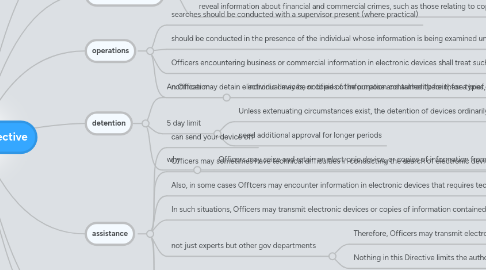
1. purpose and scope
1.1. To provide guidance and standard operating procedures for
1.2. searching, reviewing, retaining, and sharing information
1.3. contained in computers, disks, drives, tapes, mobile phones and other communication devices, cameras, music and other media players, and any other electronic or digital devices,
1.4. encountered by U.S. Customs and Border Protection (CBP) at the border, both inbound and outbound, to ensure compliance with customs, immigration, and other laws that CBP is authorized to enforce.
1.4.1. electronic device def
1.4.1.1. Electronic Device. Includes any devices that may contain information, such as computers, disks, drives, tapes, mobile phones and other communication devices, cameras, music and other media players, and any other electronic or digital devices.
2. what do they find?
2.1. Searches of electronic devices help detect evidence relating to terrorism and other national security matters, human and bulk cash smuggling, contraband, and child pornography.
2.2. reveal information about financial and commercial crimes, such as those relating to copyright, trademark and export control violations
3. operations
3.1. searches should be conducted with a supervisor present (where practical)
3.2. should be conducted in the presence of the individual whose information is being examined unless there are national security, law enforcement, or other operational considerations that make it inappropriate to permit the individual to remain present.
3.3. Officers encountering business or commercial information in electronic devices shall treat such information as business confidential information and shall protect that information from unauthorized disclosure
3.4. notification
3.4.1. individual may be notified of the purpose and authority for these types of searches, how the individual may obtain more information on reporting concerns about their search, and how the individual may seek redress from the agency if he or she feels aggrieved by a search
4. detention
4.1. An Officer may detain electronic devices, or copies of information contained therein, for a brief, reasonable period of time to perform a thorough border search.
4.2. 5 day limit
4.2.1. Unless extenuating circumstances exist, the detention of devices ordinarily should not exceed five (5) days.
4.2.2. need additional approval for longer periods
4.3. why
4.3.1. Officers may seize and retain an electronic device, or copies of information from the device, when, based on a review of the electronic device encountered or on other facts and circumstances, they determine there is probable cause to believe that the device, or copy of the contents thereof, contains evidence of or is the fruit of a crime that CBP is authorized to enforce
5. assistance
5.1. can send your device off
5.2. Officers may sometimes have technical difficulties in conducting the search of electronic devices such that technical assistance is needed to continue the border search.
5.3. Also, in some cases Offtcers may encounter information in electronic devices that requires technical assistance to determine the meaning of such information, such as, for example, information that is in a foreign language andlor encrypted (including information that is password protected or otherwise not readily reviewable).
5.4. In such situations, Officers may transmit electronic devices or copies of information contained therein to seek technical assistance from other federal agencies. Officers may seek such assistance with or without individualized suspicion.
5.5. not just experts but other gov departments
5.5.1. Therefore, Officers may transmit electronic devices or copies of information contained therein to other federal agencies for the purpose of obtaining subject matter assistance when they have reasonable suspicion of activities in violation of the laws enforced by CBP.
5.5.2. Nothing in this Directive limits the authority of CBP to share copies of information contained in electronic devices
5.6. approval
5.6.1. Requests for translation, decryption, and subject matter assistance require supervisory approval and shall be properly documented and recorded in CBP systems of records.
5.6.2. responses from an assisting agency should be received within fifteen (15) days
5.7. security
5.7.1. CBP will appropriately safeguard information retained, copied, or seized under this Directive and during transmission to another federal agency. Appropriate safeguards include keeping materials in locked cabinets or rooms, documenting and tracking copies to ensure appropriate disposition, and other safeguards during transmission such as password protection or physical protections
